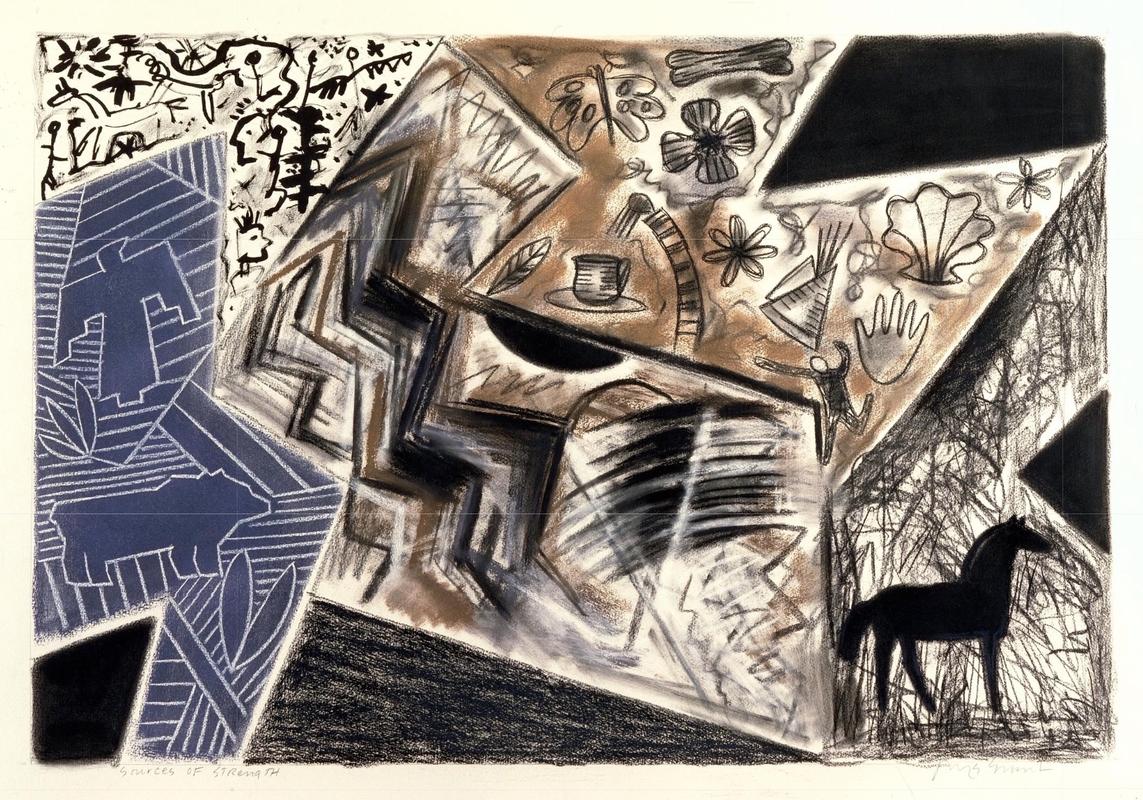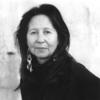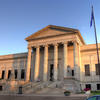More about Sources of Strength

Contributor
Jaune Quick-to-See Smith's pastel-and-ink Sources of Strength uses symbolism to express the artist's vision of native people's power.
The figures of the bear and Thunderbird appear in "petroglyph" form, according to a curator at MIA. Petroglyphs are ancient carvings that populate the American landscape. The bear image is based on the actual bear, but the Thunderbird is particular to indigenous people, especially the Ojibwe and other nations grouped by linguists in the Algonquian language family. The Thunderbird, which you might confuse with the Ford car of the same name, has a striking geometric shape. The shape of the underside of the Thunderbird's wings projects a sharp, rectilinear, almost pixelated form that stops you in your tracks.
Ironically, writes late Keetoowah Cherokee Asst. Chief G. William Rice, the US government has no legally consistent definition of the political category "Indian," using it for different purposes based on either lineal genealogy, enrollment, or registration. In a page straight from Alice in Wonderland, Rice explains that it's possible to be an "Indian non-Indian" or even a "non-Indian Indian" in Federal Indian Law. For native people themselves, belonging depends on the definitions of the community, particularly the elders, who may not be in agreement with the nation's council leadership. All of this doubt and inconsistency can cause people to tell Quick-to-See Smith that her work is not "native enough," providing a ridiculous bookend to the earlier assertion of her art teachers that her work was "too native." Huh? Nobody's calling Queen Elizabeth "too British."
Smith is enrolled in the Salish-Kootenai nation, and she is of Salish, Nehiiyawak, and Aqui-Dika ancestry. Because these names might be unfamiliar to you, the MIA gives alternate names which may be easier: "Salish-Cree-Lemhi Shoshone." The names "Cree" and "Shoshone" are what ethnologists call "exonyms," names for people who originate with other groups, usually neighbors and adversaries. By replacing those "exonyms" with the "endonyms," the words which the people themselves use to describe themselves, the artist employs something which we call "magic" in English, which might approximate a word which we often see, in the translation of Plains indigenous texts, translated as "Power," "Spiritual Power," or, as the artist uses it here, "Strength." It takes chutzpah to have Power, and it's not the same as political power, although they are related.
As the Lakota elder Lawrence Antoine said to a group of academics visiting from California, "You want to know where the Power come from—I know; everybody wants to find that out. We got—Indi’ns got a name for all them powers...But the powers are mysterious; they don’t like you to tell all about things. You don’t tell all you see in your vision; it loses its power." Antoine explains that there was Power in medicine bundles destroyed by settlers and that both men and women have Power. Power (or Strength) is closely associated with the sovereignty of a people linked with a particular place and language.
Sources of Strength is one of 578 works the MIA credits to the Christina N. and Swan J. Turnblad Memorial Fund. "Swan" is not a common baby name, especially for a man, but it is the name of the Swedish newspaper tycoon who published a Minneapolis paper in his native tongue. He Anglicized his name from Sven to Swan.
Sources
- Rice, G. William, Tribal Governmental Gaming Law: Cases and Materials. Durham, NC: Carolina Academic Press, 2006.
- Slagle, Al Logan. Somebody did Medicine: Voices of Native American Elders. Los Angeles: University of California, 1978.
- "Sources of Strength." MIA, https://collections.artsmia.org/art/4474/sources-of-strength-jaune-quic….
- George, Shilo. "Jaune Quick-to-See Smith - Salish/Kootenai." Contemporary North American Indigenous Artists, Winter 2011, https://contemporarynativeartists.tumblr.com/post/6346633044/jaune-quic….











